AEGINA
Religion

Religion

Popular destinations GREECE
| Aegina | Alonissos | Andros |
| Chios | Corfu | Crete |
| Hydra | Kalymnos | Karpathos |
| Kefalonia | Kos | Lefkas |
| Lesbos | Mykonos | Naxos |
| Paros | Patmos | Peloponnese |
| Poros | Rhodes | Samos |
| Santorini | Skiathos | Skopelos |
| Spetses | Thasos | Zakynthos |
Religion
Mythology
Aegina or Aegina (Greek: Aigina) is the name of a figure from Greek mythology. Aegina was a nymph, daughter of the river god Asopus, and was loved by Zeus. The supreme god Zeus took her to the uninhabited island of Oenone in the Gulf of Aegina (between Attica and Argolis), where she gave birth to a son Aeacus. Later, in honor of his mother, he would change the name of his native island to Aegina.
Religious buildings
One of the best preserved masterpieces of ancient Doric architecture is the Temple of Aphaia or Afaia. 25 of the original 32 columns can still be seen, either in original condition or restored. The remains of the temple are located on a hill in the east of Aegina near the seaside town of Agia Marina, with beautiful views of Athens and Piraeus.
The current remains date from the early 5th century BC and were built just after the Battle of Salamis. The striking position of the statue of Aphaia on two facade structures suggests that the residents of Aegina equated Aphia with the much more famous Olympic goddess Pallas Athena.
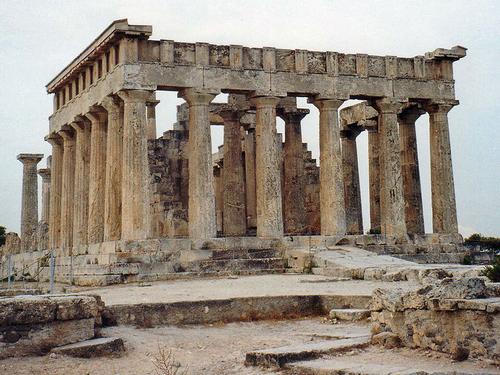 Temple of Aphaia at AeginaPhoto: Alun Salt CC 2.0 Generic no changes made
Temple of Aphaia at AeginaPhoto: Alun Salt CC 2.0 Generic no changes made
The Agios Nektarios Monastery / Church, one of the largest monasteries in the Balkans, is located six kilometers away from Aegina town on Xantos hill. The monastery is named after Saint Nektarios, who died in 1920 and was canonized by Rome in 1961. The women's monastery is still home to a small number of nuns and there is a large guest house. The monastery was built from 1904 to 1910 by the then Bishop Pentapoleos Nektarios. Noteworthy are a painting of the canonization of Saint Nektarios, a mosaic floor showing monasteries on surrounding islands and a carved iconostasis.
November 9 is the celebration of Nektarios name day, on that day the monastery is visited by thousands of people. In 1994, the church part of the Agios Nektarios was consecrated as a cathedral and is known, at least to the locals, as the largest Greek Orthodox church after the Aya Sofia in Istanbul.
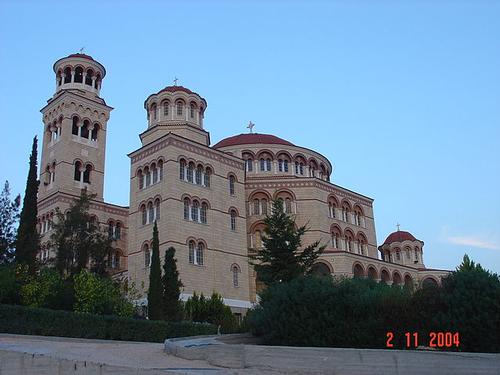 Agios Nektarios, AeginaPhoto: Eustaquio Santimano CC 2.0 Generic no changes made
Agios Nektarios, AeginaPhoto: Eustaquio Santimano CC 2.0 Generic no changes made
Very interesting is also the nunnery (since 1935) of the virgin Panaghía Chryssoleontissa, located on the road to Marathon. The monastery, with limited viewing, was built in 1600 in the style of the fortified monasteries of Mount Athos. Inside the church is a beautiful carved iconostasis from the 17th century.
Scattered around the island are the churches Eisódia tis Theotókou and Aghii Theódori or 'Omorphi Ekklisía' in Aegina town and Aghios Geórgios Katholikós, Aghios Dionysios and Aghios Nikólaos in the once-church-dotted Palaiochóra, the already more than 200 years abandoned medieval town of Aegina, which was the island's capital until the 19th century. Of the more than 100 chapels and churches there are now about 20 left
South of Aegina town, near the hamlet of Pachiá Ráchi, is the 14th century church of Taxiárchis.
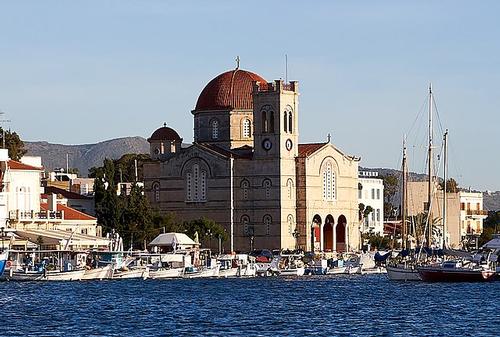 Eisodia tis Theotókou, church at AeginaPhoto: George E. Koronaios CC 4.0 International no changes made
Eisodia tis Theotókou, church at AeginaPhoto: George E. Koronaios CC 4.0 International no changes made
Greek Mythology
The word myth is derived from the word "muthos", which first meant utterance and was later often interpreted as "a spoken or written story".
Mythology (muthologia) is thus "telling stories", or a collection of myths, or the study of myths.
When writing originated in Greece, myths and legends were already anchored in oral traditions, and later poets in particular gave the stories a different course. Greek mythology is very similar to other mythologies. For example, the Norse god Odin corresponds to the Greek Zeus and the Norse heroes often performed the same heroic deeds as their Greek colleagues.
Some Greek gods
Aeolus (Aiolos)
A son of Hippotes, who was appointed by Zeus as guardian of the winds. He was in charge of the (wind) gods: Boreas, Zephyros, Notos and Euros.
Aphrodite
Aphrodite is the goddess of love and beauty. She was born from the foam of the sea, where the main shrine dedicated to Aphrodite is located. She was married to Hephaestus, but preferred Ares for a lover.
Her son was Eros, the god of love. Aphrodite is depicted with the winged Eros and with doves. She was one of the Olympian gods. The Romans called her Venus.
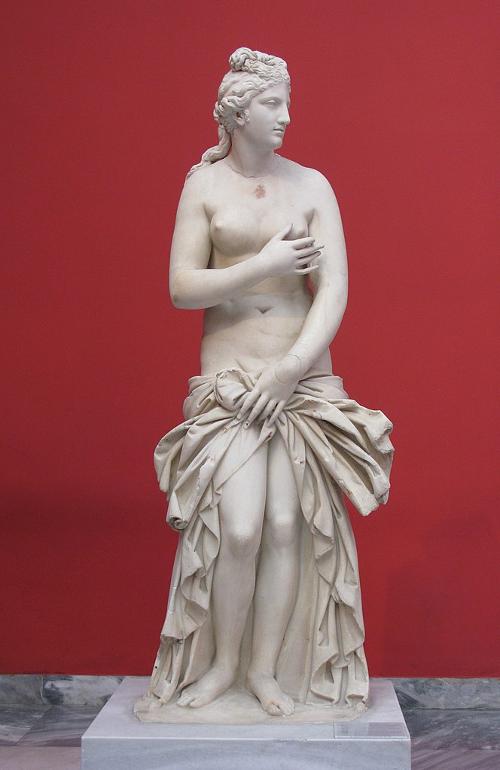 Aphrodite, goddess of love and beautyPhoto: Tilemahos Efthimiadis CC2.0 Generic no changes made
Aphrodite, goddess of love and beautyPhoto: Tilemahos Efthimiadis CC2.0 Generic no changes made
Apollo
Apollo was the son of Zeus and Leto, and the twin brother of Artemis. He is god of light, of medicine, music and science. Apollo is often depicted with a lyre in his hand. The main shrine dedicated to Apollo is located in Delphi, the most important oracle site of ancient Greece. Apollo was an Olympic god.
Ares
Ares was a son of Zeus and Hera and is the god of war. He is often depicted in full armor and was an Olympian god. The Romans take him Mars.
Artemis
Artemis was Apollo's twin sister and daughter of Zeus and Leto. She was the goddess of nature and the hunt. She was also the tutelary goddess of pregnant women and is often depicted with a bow in her hand. She was an Olympian god and her Roman name is Diana.
Dionysos
Dionysos was a son of Zeus and god of grapes and wine. He is often depicted with a staff that is wrapped at the top with ivy leaves. He was an Olympian god and his Roman name is Bacchus or Liber.
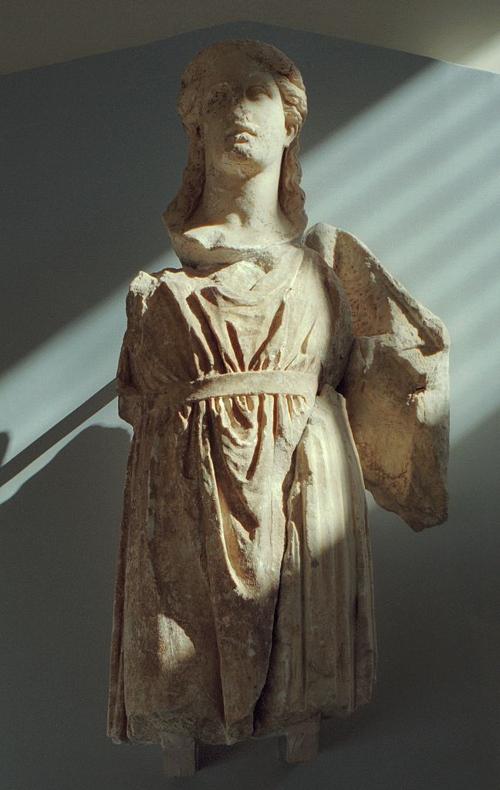 DionysosPhoto: Zde CC 4.0 International no changes made
DionysosPhoto: Zde CC 4.0 International no changes made
Eros
Eros is the god of needs and is also called Himeros. Eros is often seen as a winged boy god who shoots men in the heart with love arrows. Roman names for him are Amor and Cupid.
Hermes
Hermes was the messenger of the gods and a son of Zeus. He is also god of travelers, thieves, and merchants. He is always depicted wearing a traveler cap and staff or a helmet with wings. His sandals also have wings. He escorted the ghosts of the dead to the underworld, Hades
Pallas Athena
She is the daughter of Zeus only, because born from his forehead. She is the patron goddess of the artists and craftsmen, but also the goddess of wisdom and knowledge. In wartime Athena was also revered as a war goddess. She was the special guardian goddess of the city of Athens and a guardian angel of Greek heroes such as Heracles and Odysseus.
She is often depicted wearing a helmet and full armor. The owl, which symbolizes wisdom, was devoted to her. Pallas Athena has a sanctuary located in Athens: the Parthenon.
She was an Olympic god and her Roman name is Minerva.
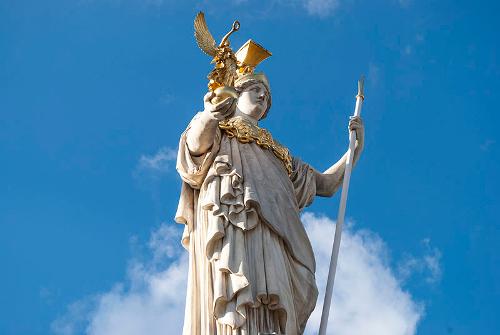 Pallas AthenaPhoto: Diana Ringo CC 3.0 Austria no changes made
Pallas AthenaPhoto: Diana Ringo CC 3.0 Austria no changes made
Poseidon
Poseidon is a helm of Zeus and is the god of the sea and guardian god of the sailors. His palace is deep under water and he is often depicted with a trident, with which he can stir the sea. The horse was dedicated to him.
Since the Greeks believed that the land floated on the sea, they also considered him the god who caused the earthquakes. The Roman name is Jupiter.
Zeus
Zeus was the supreme god of the Greeks and the king of gods and men. He was also the god of the sky and the weather. He is often depicted with a lightning in his hand and is seated on a throne. Many demigods and heroes, such as Hercules and Perseus, arose from his love affairs with beautiful women.
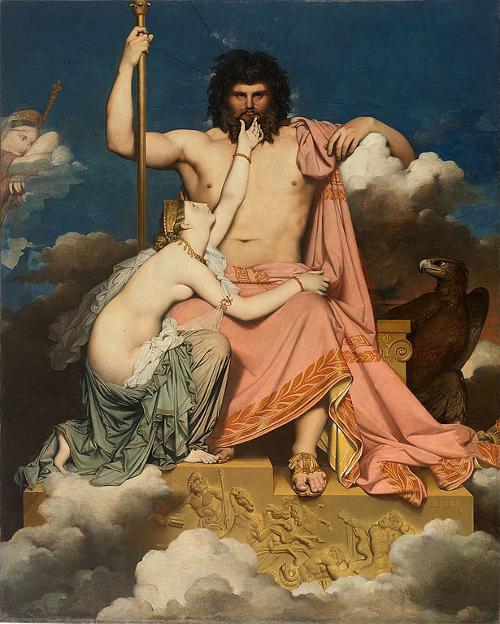 Zeus and ThetisPhoto: Public domain
Zeus and ThetisPhoto: Public domain
Sources
Wikipedia
CIA - World Factbook
BBC - Country Profiles
Last updated June 2025Copyright: Team The World of Info